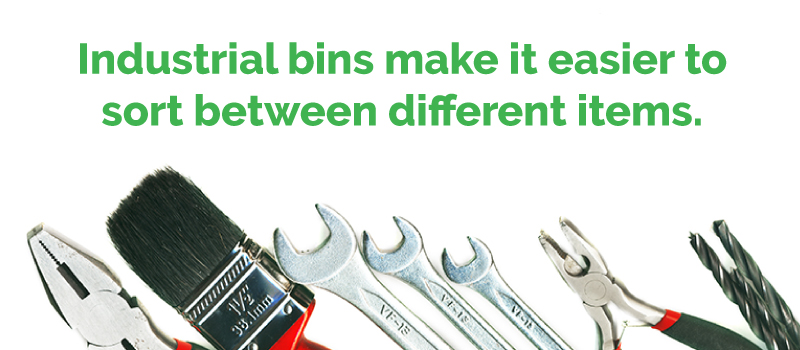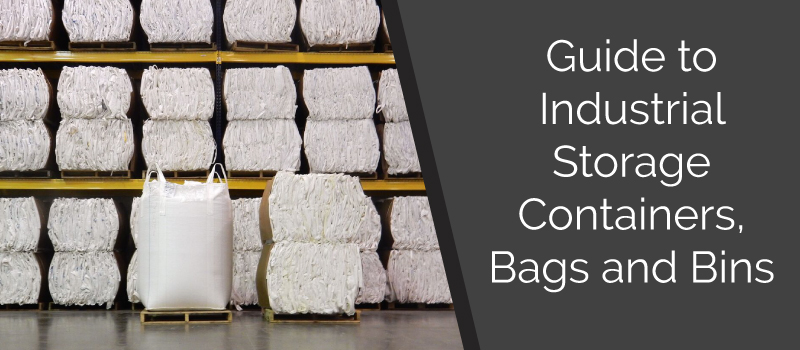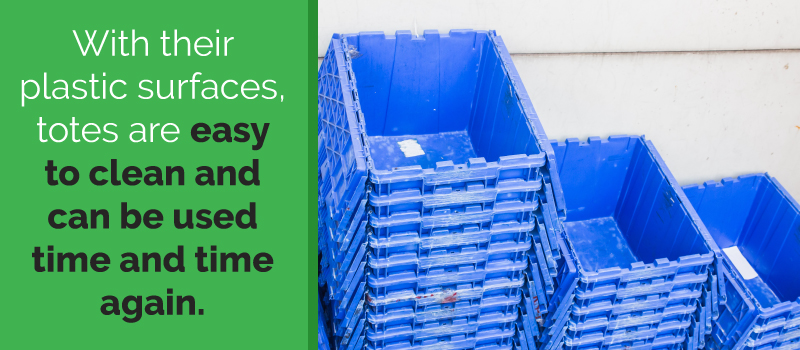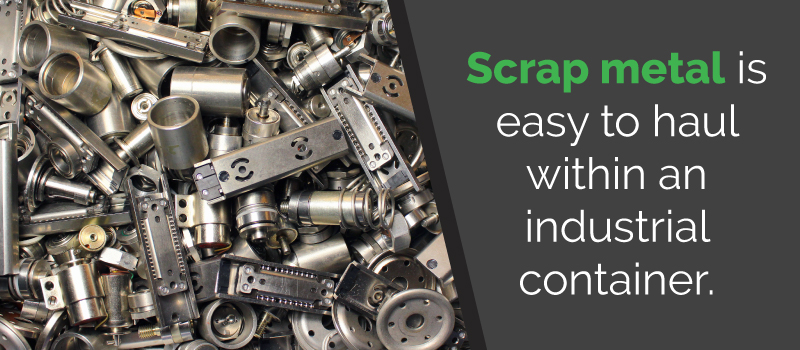In factories and warehouses, there are various ways to get items moved from one area to another during the course of a shift. Sure, items can be lifted and carted around in small bags and boxes, but the more effective means for transporting and holding materials is with the use of industrial bins, containers, totes and bulk storage bags.
While the various types of containers discussed below are optimal for a range of storage and maintenance tasks, it’s important to understand the individual strengths of each type. After all, the items you’d put in a plastic tote are different than what you’d place in a metal container. Likewise, the bulk contents that go into storage bags might not empty as easily from a larger, more solid structure. The following sections cover the benefits, drawbacks and most suitable materials to store in bags as well as bins and containers.
What are Industrial Totes and What Can They Store?
When it comes to storing and hauling loads of equipment and refuse, industrial plastic totes make the job clean and easy. With their plastic surfaces, totes are easy to clean and can be used time and time again. Totes are used to store and cart a range of items across factory floors and worksites areas. A tote is ideal for holding and hauling items such as:
- Tools. An industrial plastic tote is one of the most suitable containers for items like saws, drills, wrenches and hammers. Thanks to the plastic interior walls, tools are less liable to get damaged when carted around from one location on a worksite to another.
- Fasteners. A typical construction project will require hundreds, if not thousands, of fasteners. Whether the job in question calls for nails, rivets, screws, nuts or bolts, an industrial plastic tote can contain these and other fasteners by the bulk load.
- Bark dust. Totes are convenient for storing and hauling, whether you store several bags of bark dust per tote, or simply pour the product straight into the tote. When the time of the year rolls around where bushes and tree sides call for fresh layers of bark, the task can easily be accomplished with the help of a tote.
- Dry cement. Not all paving jobs require a cement truck. When cracks and chips form on certain parts of sidewalks and driveways, a touch-up supply of cement is enough to do the job properly. A tote can be used to haul bags or bulk supplies of dry cement to problem areas.
- Cords. One of the messier items in construction and assembly is the cord. Whether cords are being removed from the dark spaces of old buildings or carried around for fresh installations, a plastic tote makes it easy to cart around dozens of thin as well as bulky cords.
- Wires. A lot of projects call for wire, which can be difficult to haul around, let alone store, in bulk quantities unless it’s properly contained. Otherwise, wire can come unraveled and cause a tangled mess, whether you’re dealing with fresh wire for new projects or old scraps of wire from scraped structures.
- Smaller boxes. When you have a handful of boxes that contain heavy or delicate items, it’s easier to move them around in a larger container. In a plastic tote, boxes can be stacked for tidy storage as well as smooth delivery from point A to point B.
- Cleaning products. As with boxes, cleaning supplies can be a handful or an armful when manually taken from one area to another. Likewise, fluid containers can take up space on shelves that could be much better consolidated inside of a plastic tote.
If there’s a drawback to totes, it’s the nature of plastic, which can be soft on the items it contains, yet can ultimately be vulnerable to blunt edges over time. Depending on the strength of an industrial plastic tote and the items it’s used to store and haul, a tote could last for several years if it’s routinely cleaned and stored properly.
One way to keep industrial plastic totes cleaner is with the use of tote liners, which you place inside the tote container to protect the interior walls from liquids and hardening substances like cement or mortar. While a tote liner can only be used once, it can spare you the trouble of having to clean a tote at the end of a work project.
Industrial Containers
For larger and bulkier items, industrial containers make it easy to keep things stored and in one spot for transportation. Due to the metal interior, an industrial container is more appropriate for items that — unlike tools and small pieces of machinery — lack any surface sensitivity. The types of items for which industrial containers are the best means of storage and transportation include:
- Scrap metal. In factories and assembly plants, metal pieces of varying sizes could be needed for a number of projects. Alternately, metal scraps could be extracted during the disassembly of retired machines, structures and vehicles. Whatever the case, scrap metal is easy to haul within an industrial container.
- Garbage. Few things are more abundant at worksites and factories than garbage. Luckily, industrial containers are sleek and stainless due to their metal interior, which makes such containers ideal for holding and carting off garbage at construction sites and along assembly lines.
- Branches. At outdoor worksites, large industrial containers are ideal for holding branches that are cut from bushes and trees. From there, the container makes it easy to cart the branches to a landfill, or to a shredder to have them broken down for use as sawdust.
- Discarded tubing. There’s no telling what might come loose when machines and structures are being disassembled. Used or worn tubes are often filthy and hard to handle. But within the metal confines of an industrial container, problem solved.
- Dirt. At any site that involves digging, dirt will be in abundance. When cement, plants or building structures take place of uprooted dirt, the latter can be dumped into industrial containers and carted off for redistribution at another location.
- Gravel. One material that can be hard to store and cart without a strong container is gravel, which is generally too heavy for bags and too rough for plastic containers. With an industrial container, gravel can be loaded up for distribution along lawn trimmings and outdoor structures.
- Bricks. Bricks are among the heavier of construction pieces, and are, therefore, difficult to cart to and from work locations without large industrial containers. Whether the project involves repairing a chimney or the walls of an old public school building, metal containers have the strength and capacity to hold and haul large amounts of bricks.
- Recyclables. Throughout a given project or work shift, various items are bound to be tossed aside that could easily be recycled. Out of all the industrial storage options, large metal containers are the most appropriate for handling the range of items that are bound to wind up in a recycling bin.
- Broken glass. Of all the items to be recycled or discarded at a worksite or industrial setting, few require as much care as glass. As one of the most dangerous elements, glass can cause damage and injury if it’s not contained properly. With industrial containers, glass can safely be contained and removed from a working environment.
Industrial containers come in a range of sizes, and so they are ideal for projects that involve various amounts of products and waste.
Industrial Warehouse Bins
Along the storage aisles of warehouses, industrial bins make it easier to sort between different items. Whether you’re dealing with supplies for a factory or overstock for a department store, industrial warehouse bins serve as makeshift drawers that are typically sold in bright yellow, blue and red for simple color-coding.

- Fasteners. Industrial warehouse bins help simplify the process of arranging fasteners into distinct size categories. This way, people on the floor have no difficulty finding the exact screw size or nail length, because fasteners of one type can always be found in a specific bin or row of bins.
- Tools. With industrial warehouse bins, tools can be arranged by color across shelves. Therefore, smaller sizes and models of a screwdriver or wrench can be placed on one shelf in yellow bins, while larger versions of the same types of tools can be arranged in blue bins on the shelf above.
- Tape rolls. Anything on a small roll or reel — be it tape, cord or chain — can be organized in warehouse bins according to color, thickness and other distinguishing attributes. In factories, this allows for a much tidier way to arrange these sorts of items, which are generally known to be messy.
- Engine parts. Vehicle owners generally replace their engines on a part-by-part basis. Therefore, it’s imperative for auto parts warehouses to keep endless stocks of the various engine parts that need to be changed out every few years, such as pistons and pulleys.
- Safety gear. Items such as gloves, goggles and safety masks need to be replaced constantly. Rather than hanging all of these items on overstuffed hook racks, each can be found easier when organized into separate color-coded bins on the shelves of factory warehouses.
- Surplus. A lot of the items stored in warehouse bins are the leftover parts of various machines, gadgets and product containers. From rubber knobs and computer-speaker stands to jar lids and plastic bottle caps, thousands of different pieces can have their own small bin on the shelves of a large warehouse.
Since they’re made of plastic, warehouse bins are not suitable for warmer items, such as anything that’s recently been inside an active engine or heater. Otherwise, industrial bins are ideal for anything small, contained and relatively lightweight.
Storage Bags for Warehouse Facilities
Solid containers like bins and totes are far from the only storage devices for the various materials that are needed in abundance at factories and warehouses. Another option is the storage bag, which can be used to hold bulk supplies of items until they’re needed for the department shelves or assembly lines. Warehouse storage bags are especially suitable for lighter and looser items, such as the following:
- Fabric. Many types of fabrics can be rolled up and stored inside warehouse bags. From bulk fabrics for industrial use to backroom stocks of elastic cloth, storage bags for warehouse usage are an ideal option for storing back-up supplies of materials that would otherwise take up numerous yards of shelf space.
- Foam. Another material that serves a number of warehouse uses is foam, which can be space-consuming along aisles. With storage bags, foam is easy to transport and hold on shelves in a more orderly manner until the material is actually needed.
- Rags. In factory settings, there’s an endless need for clean towels and rags. Since a lot of these rags are only used once, the storage space for rags must be managed efficiently. With storage bags for warehouse use, factories can receive hundreds of rags per bag, which can then be opened as needed.
- Packing peanuts. If there’s anything in a warehouse that needs to be contained, it’s packing peanuts. As the lightest and most air-filled of packing materials, these peanuts will fly everywhere if not confined to a box or bag, which makes the latter option ideal for the supply aisles in large working facilities.
- Foods. Various types of produce, such as onions, are transported from farms to supermarkets in mesh storage bags. Likewise, bulk edible granules like flour and cornmeal are transported in solid storage bags.
Warehouse storage bags can either be hung upright or stacked on shelves. As such, storage bags for warehouses are among the more flexible of options for supply room and factory operators.
Bulk Storage Bags
One of the most unique devices for holding vast quantities of loose product is the bulk storage bag, which in some ways, combines the benefits of a box and bag into one. Like a box, bulk storage bags have four sides and a bottom. With handles at the top of each corner, each bag is suspended and emptied of its bulk contents. The versatility of these bulk bags can help improve warehouse operations.
Bulk bags are made with the following designs:
- Duffle top. Bulk storage bags of the duffle top design feature a fill opening, which elongates the height until the bag is closed. This way, a bag can be filled with bulk from an overhead dispenser. Once the bag has filled, the duffle top is sealed. Duffle tops can also be added to circular bulk sacks.
- Spout top. Featuring a thinner, chute-like opening, the spout top bag allows for a cleaner filling process. Bulk products are dispensed from above into the chute opening at the center of the bag top. With this design, less dust is produced during the filling process.
- Open top. Bulk storage bags that lack top panels are known as open top, which are easier to fill but are best reserved for items that don’t need protection from ambient air.
Bulk storage bags can be emptied in one of the following ways, depending on the design of the particular bag:
- Spout bottom. Basically, a chute at the bottom allows products to be emptied out of the bag in much the same way that they were poured in.
- Plain bottom. With duffle top bags, a plain bottom means the contents must be emptied through the sprout top. An alternate way to empty a plain bottom bag is to simply cut it open from underneath. Consequently, plain bottom bags are often discarded after one use.
- Full bottom. A design where the bag fully gives way at the bottom to release the entirety of bulk contents. The full bottom bag is ideal for contents that are lumped together.
A bulk storage bag can be used to hold and transport some of the product categories already mentioned in this article, such as bark dust, dirt and dry gravel. In certain instances, bulk storage bags are also used to transport dangerous contents, though this generally requires special labeling.
Get Industrial Storage Bags From Bulk Bag Reclamation
Throughout the industrial sector, bulk bags are used to hold and transport numerous contents. For these bags to be reliable, they must consist of strong material and be made to bear heavy amounts.
At Bulk Bag Reclamation, our bags are designed to handle heavy loads in factory settings. Contact us today to learn more about our bulk bags for sale.




